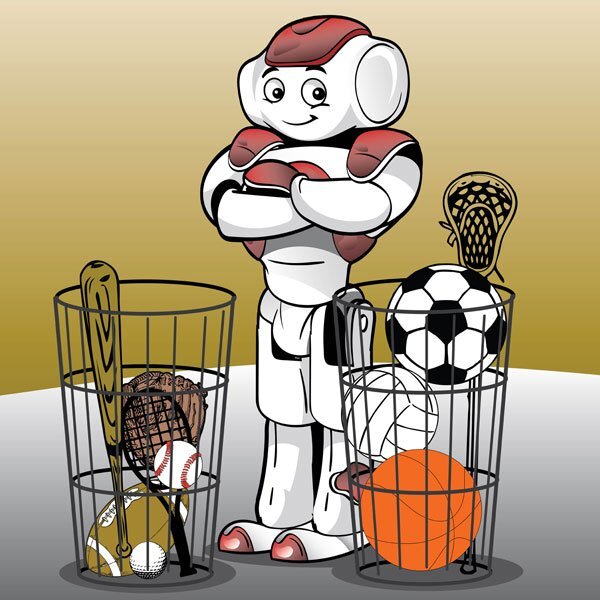Lesson Modules
Teaching Tips:
Activate the corresponding program. The robot has its hands out. One of three balls (tennis, soccer, football), is given to the robot and depending on its size the robot will twist its body and/or move to put in one of three bins.Observe what your teacher shows with the robot.
Teaching Tips:
Act 1:
Understanding piecewise functions. The ball is described by its diameter (in the case of the football it is the longer diameter). A piecewise function that describes the bin to which each ball belongs can be written as
/lesson%208%20image%201.png)
Where D is the diameter of the ball and (d1, d2), (d3, d4), (d5, d6) are the approximate bounds of the diameter of a tennis, soccer, football, ball respectively.
The simulator shows the robot with its arms outstretched. On the side of the screen, there is a table that lists d1 to d6. The student presses a button and a ball is given to the robot. The robot is turned to the side so the students cannot see the size or shape of the ball. The robot speaks out the diameter of the ball and the student has to then click the correct bin and the robot will then put the ball in the selected bin. The student gets a point for every ball that has been placed correctly.
Understanding piecewise functions.
The ball is described by its diameter (in the case of the football it is the longer diameter). A piecewise function that describes the bin to which each ball belongs can be written as
/lesson%208%20image%201.png)
Where D is the diameter of the ball and (d1, d2), (d3, d4), (d5, d6) are the approximate bounds of the diameter of a tennis, soccer, football, ball respectively.
Direction: Use the simulator to sort out the balls into the right bins by using a peicewise function.
- Press a button and a ball is given to the robot.
- Listen to the robot. It will speak out the diameter of the ball.
- Click the correct bin and the robot will then put the ball in the selected bin.
- You will get a point for every ball that has been placed correctly.
Teaching Tips:
Act 2:
The student has to virtually measure several balls of the same type to determine the appropriate bounds for the piecewise equation that determines the bin for each ball.
If appropriately estimated, the robot can automatically sort the balls.
The simulator will look something like the figure below:
/lesson%208%20image%202.png)
There are several of the same type of balls present on the table and on the floor. The student can click on a ball and the diameter will appear on the screen. Balls of the same type will have slightly different diameters (for example, one tennis ball may be 2.6” in diameter and another 2.7”). By checking all the balls the student can then identify the bounds that can be used in the equation which need to be typed in a table on the screen. Once the student has typed in all the bounds, they can click on the 'Start' button for the simulation. During the simulation, the robot will go to a ball, pick up the ball, say the diameter out loud and then place it in the bin specified by the bounds that the student has typed. The student gets a point for each ball correctly placed.
You need to virtually measure several balls of the same type to determine the appropriate bounds for the piecewise equation that determines the bin for each ball.
If appropriately estimated, the robot can automatically sort the balls.
Simulator:
/lesson%208%20image%202.png)
Direction:
- Click on a ball on the table or on the floor and see the diameter that appears on the screen. Be aware that balls of the same type will have slightly different diameters (for example, one tennis ball may be 2.6” in diameter and another 2.7”).
- Identify the bounds that can be used in the equation and type the bounds in a table on the screen.
- Click on the 'Start' button for the simulation. During the simulation, the robot will go to a ball, pick up the ball, say the diameter out loud and then place it in the bin specified by the bounds that you have typed.
- You will get a point for each ball correctly placed.
Teaching Tips:
Close: (5 mins)
Students will explain how interpreting and building piecewise functions, the NAO robot can clean up a garage.

